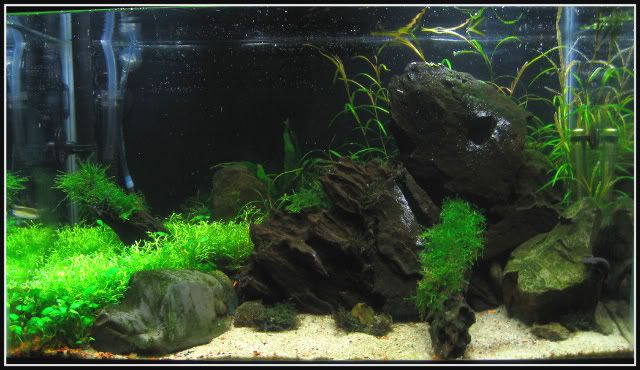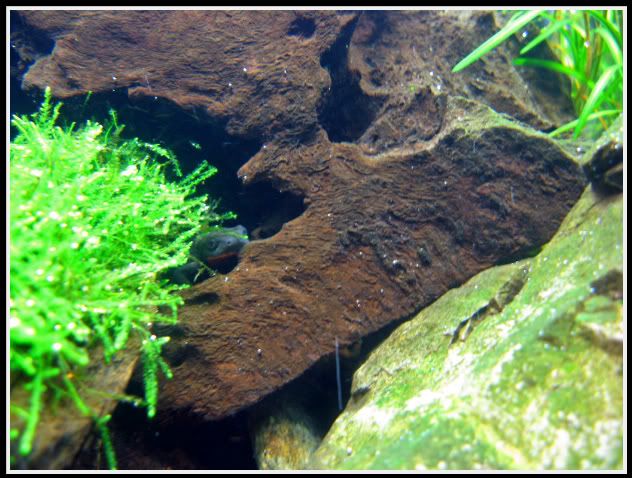Agrippa
New member
- Joined
- Jun 21, 2008
- Messages
- 12
- Reaction score
- 3
- Points
- 0
- Location
- Colorado
- Country
- United States
- Display Name
- Ben
Hello everyone.
After looking at everyone else's enclosures for their Caudates, I figured that perhaps I should get around to posting mine as well.
My 10g AGA has been set up in its current incarnation for about 3 months.
The flora was chosen specifically to tolerate the lower temperatures demanded by C. orientalis, and have been growing well, if somewhat more slowly than usual.
The rock and driftwood formations were designed to provide many small caves, hiding spots, and perches for the inhabitants. It should also be noted that the water level is usually about 1.5 inches lower, to permit the newts to climb out on the driftwood or on the plants.
Flora includes:
Potamogeton gayi,
Ludwigia sp.,
Microsorum pteropus (Java fern,)
Lilaeopsis novaezelanidae (Brazilian microsword,)
Micranthemum quadrifolia/hirsuta (Four leaf clover,)
Riccia fluitans,
Taxiphyllum alternans (Taiwan moss,) and
Monosolenium tenerum (Pellia.)

I just trimmed a number of the plants on Friday, so pleas pardon the scraggly look at the moment.
To keep the plants healthy and growing, I run 4x18w compact fluorescent bulbs that I took from cheap desk lamps and retrofitted into a hood, giving me 72w. The lights are, in turn, supplemented by CO2 diffusion at about 20ppm, and I dose macronutrients and traces each morning per PPS (a planted aquarium fertilizer regime.)
Now, I know some of you are ready to jump on me about the lights heating the tank to intolerable levels, but don't worry- I've worked something out for this particular issue. Despite average temperatures between 80-90 degrees Fahrenheit out here, the aquarium stays at a stable 66 Fahrenheit during the day, and drops to about 62 F at night. I manage this by using a computer fan that I've wired and mounted to the hood to help lower temperatures with evaporation during the day, in combination with my DIY canister filter/chiller that I built for this purpose. You can see the setup here:

Basically, it consists of a small powerhead inside of a small locking tupperware that has been plumbed into the aquarium. It contains porcelain rings and nylon scrubbers for biological and mechanical filtration. This, in turn, sits within a lunch box, which is filled with ice and frozen bottles. I zip it shut, and it lowers tank temperatures by between 6 and 10 degrees, which, in combination with the fan, keeps the tank at an acceptable temperature. The only problem with this setup is that, every six or so hours, I have to unzip the lunchbox and replace the ice; however, despite the constant chore of ice-replacement, I find this option rather preferable to buying an extraordinarily expensive aquarium chiller or spending $60 per month on running my air conditioning 24/7.
Now, for tank inhabitants, I currently have 2 C. orientalis:
Smudge:

And Lt. Porky:

My girlfriend named them- Smudge for the blurry, grey colour of his body, and Lt. Porky because of the newt's big gut and the orange bars on his shoulders.
In addition to the newts, I have 2 Caridinia japonica (Japanese algae-eaters,) 1 Atyopsis moluccensis (Bamboo shrimp,) and 2 Beaufortia kweichowensis (Chinese hillstream loaches.) You can click on the links to see images of them in my aquarium (the post was getting a little picture-intensive...) I apologize for the quality of these photos- my camera is just a point-and-shoot, and the flash necessary to capture pictures of them at night somewhat distorts the colours.
The C. japnonica are included here for algae control, and seem to be tolerating the lower temperatures very well. They're quite active and growing well, and the firebellies don't seem to pay them any attention. The bamboo shrimp is an extremely passive filter feeder, and he and the newts seem to be mutually empathetic of one another. I've seen the shrimp just sit there as a newt walked on top of him. Finally, the Chinese hillstream loaches, a coldwater, stream fish (tolerant of even the winter temperatures that the tank will fall to) are in there for control of film algae. They are very peaceful and usually slow moving, but can swim very quickly if they're frightened. They're also largely nocturnal, so they do not often cross paths with the newts.
Finally, here are some random photos of the aquarium:
Riccia fluitans pearling, several hours after lights-on

And, a newt's eye view of the aquarium:

Thanks for looking, and please feel free to leave comments- even if it's just to tell me I'm a fool for mixing R. fluitans with firebellies.
After looking at everyone else's enclosures for their Caudates, I figured that perhaps I should get around to posting mine as well.
My 10g AGA has been set up in its current incarnation for about 3 months.
The flora was chosen specifically to tolerate the lower temperatures demanded by C. orientalis, and have been growing well, if somewhat more slowly than usual.
The rock and driftwood formations were designed to provide many small caves, hiding spots, and perches for the inhabitants. It should also be noted that the water level is usually about 1.5 inches lower, to permit the newts to climb out on the driftwood or on the plants.
Flora includes:
Potamogeton gayi,
Ludwigia sp.,
Microsorum pteropus (Java fern,)
Lilaeopsis novaezelanidae (Brazilian microsword,)
Micranthemum quadrifolia/hirsuta (Four leaf clover,)
Riccia fluitans,
Taxiphyllum alternans (Taiwan moss,) and
Monosolenium tenerum (Pellia.)

I just trimmed a number of the plants on Friday, so pleas pardon the scraggly look at the moment.
To keep the plants healthy and growing, I run 4x18w compact fluorescent bulbs that I took from cheap desk lamps and retrofitted into a hood, giving me 72w. The lights are, in turn, supplemented by CO2 diffusion at about 20ppm, and I dose macronutrients and traces each morning per PPS (a planted aquarium fertilizer regime.)
Now, I know some of you are ready to jump on me about the lights heating the tank to intolerable levels, but don't worry- I've worked something out for this particular issue. Despite average temperatures between 80-90 degrees Fahrenheit out here, the aquarium stays at a stable 66 Fahrenheit during the day, and drops to about 62 F at night. I manage this by using a computer fan that I've wired and mounted to the hood to help lower temperatures with evaporation during the day, in combination with my DIY canister filter/chiller that I built for this purpose. You can see the setup here:

Basically, it consists of a small powerhead inside of a small locking tupperware that has been plumbed into the aquarium. It contains porcelain rings and nylon scrubbers for biological and mechanical filtration. This, in turn, sits within a lunch box, which is filled with ice and frozen bottles. I zip it shut, and it lowers tank temperatures by between 6 and 10 degrees, which, in combination with the fan, keeps the tank at an acceptable temperature. The only problem with this setup is that, every six or so hours, I have to unzip the lunchbox and replace the ice; however, despite the constant chore of ice-replacement, I find this option rather preferable to buying an extraordinarily expensive aquarium chiller or spending $60 per month on running my air conditioning 24/7.
Now, for tank inhabitants, I currently have 2 C. orientalis:
Smudge:

And Lt. Porky:

My girlfriend named them- Smudge for the blurry, grey colour of his body, and Lt. Porky because of the newt's big gut and the orange bars on his shoulders.
In addition to the newts, I have 2 Caridinia japonica (Japanese algae-eaters,) 1 Atyopsis moluccensis (Bamboo shrimp,) and 2 Beaufortia kweichowensis (Chinese hillstream loaches.) You can click on the links to see images of them in my aquarium (the post was getting a little picture-intensive...) I apologize for the quality of these photos- my camera is just a point-and-shoot, and the flash necessary to capture pictures of them at night somewhat distorts the colours.
The C. japnonica are included here for algae control, and seem to be tolerating the lower temperatures very well. They're quite active and growing well, and the firebellies don't seem to pay them any attention. The bamboo shrimp is an extremely passive filter feeder, and he and the newts seem to be mutually empathetic of one another. I've seen the shrimp just sit there as a newt walked on top of him. Finally, the Chinese hillstream loaches, a coldwater, stream fish (tolerant of even the winter temperatures that the tank will fall to) are in there for control of film algae. They are very peaceful and usually slow moving, but can swim very quickly if they're frightened. They're also largely nocturnal, so they do not often cross paths with the newts.
Finally, here are some random photos of the aquarium:
Riccia fluitans pearling, several hours after lights-on

And, a newt's eye view of the aquarium:

Thanks for looking, and please feel free to leave comments- even if it's just to tell me I'm a fool for mixing R. fluitans with firebellies.
